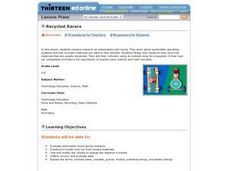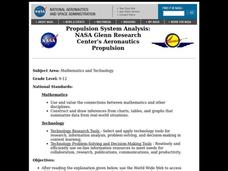Curated OER
Made to Sail
Students use simple materials to make model sailboats which must stay upright and sail straight in a testing tank.
Curated OER
Labeling Forces Correctly!
Define six common forces: propulsion, air resistance, water resistance, friction, gravity, and upthrust. A picture of a Smart Car is displayed with arrows showing all of the forces acting on it when it is motion. A picture of a rubber...
Curated OER
Rotocopters
Students construct their own rotocopters to study flight. In this flight lesson students work in groups and complete timed trials of their rotocopters.
Curated OER
Alternative Energy Part II - Lesson Eight of Eight - Energy Conversion and Propulsion
Students investigate the results of different propulsion methods. In this propulsion lesson, students measure the distance a test toy car goes using different types of propulsion. They record the distances in data tables before...
Curated OER
Recycled Racers
Students research automobile operating systems in relation to racing. They design and construct vehicles from recycled material which they race to study the concept of propulsion.
Curated OER
Newton Car
Students demonstrate Newton's Second Law of Motion by showing the reaction of a rolling car by increasing its mass and propulsion.
Curated OER
Balloon Rockets
High schoolers build pinwheel airplanes and balloon rockets to determine which ones fly faster and which fly farther.
Curated OER
The Driving Force
Pupils work in groups and note similarities and differences between their boats: size, shape, color, and unique features. They discuss 3 typical means of propulsion: propellers, sails, and paddles then share their charts with the class.
Curated OER
Aeronautics Propulsion
Students use the World Wide Web to access additional information needed to complete the activities on the forces on an airplane, the function of the stabilizer, and the calculation of Mach speed, temperature, pressure, and thrust.










